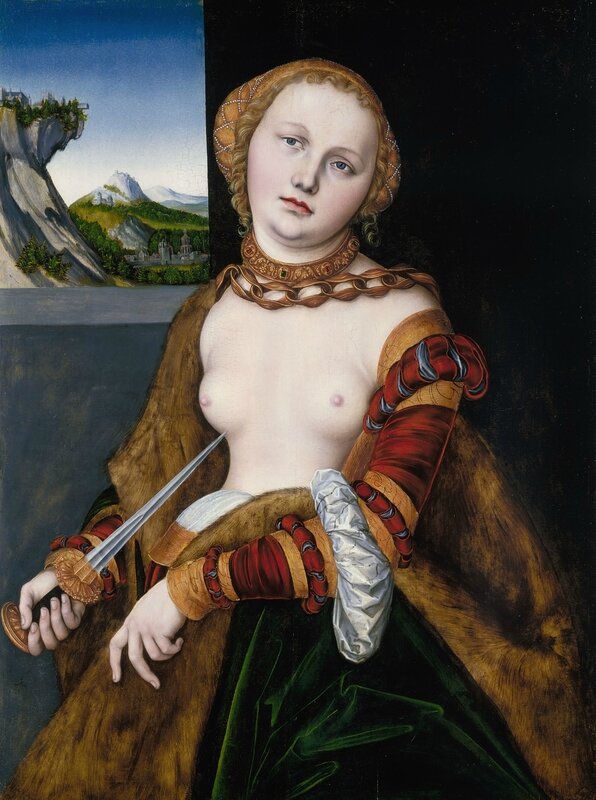Newly attributed portrait by Lucas Cranach the Elder goes on display at Windsor Castle
LONDON.- The painting Portrait of a Lady and her Son, c.1510–40, recently discovered to be by the German master Lucas Cranach the Elder (1472–1553) and his workshop is on public display at Windsor Castle from today. The painting was a Christmas gift from Queen Victoria to Prince Albert in 1840 and is part of the Royal Collection.
The double portrait shows an unidentified consort of a Prince-elector of the Holy Roman Empire and her son, their hands clasped together. Although acquired by Queen Victoria as a work by the Renaissance artist, by the early 20th century the painting was considered to be the work of Franz Wolfgang Rohrich (1787–1834). The composition has an intimacy which was thought to have been Rohrich's invention and uncharacteristic of Cranach's style. Rohrich was a prolific imitator of Cranach and produced over 40 versions of this portrait. He sold them as original works by Cranach, and they can be found in collections all over Europe.
In collaboration with TH Köln (the University of Applied Sciences, Cologne), Royal Collection Trust's conservators and curators examined the work ahead of its loan to the major exhibition Cranach der Alterer: Meister Marke Moderne at the Museum Kunstpalast, Düsseldorf in spring 2017. Infrared reflectography was used to look beneath the paint surface, revealing preliminary underdrawing typical of Cranach's work. Analysis of the pigments, metal leaf and the application of paint provided further evidence that the portrait was a work of the 16th century.
inally an x-ray of the painting revealed that a fibrous material had been used in the preparation of the panel. Analysis of similar fibres on other works by Cranach has identified them as tendons, and in one instance DNA analysis had shown them to be pigeon tendons. Sixteenth-century glue recipes often included pigeon tendons to strengthen the mixture and counteract the natural warping and splitting of the wood.
The evidence was reviewed by Professor Dr Gunnar Heydenreich of TH Köln, an expert on Lucas Cranach the Elder, who confirmed that the painting was an original work by the master from which it appears all later versions derive.
Court artist to the Saxon electors in Wittenberg, Lucas Cranach the Elder was one of the most important painters of the German Reformation, a period marked by changes in religion, philosophy, science and art. Prince Albert was particularly interested in his work, and twelve paintings by Cranach and his workshop in the Royal Collection were acquired by the Prince Consort, several as gifts from Queen Victoria.
Portrait of a Lady and her Son, c.1510–40 is shown alongside other works by Cranach and workshop in the King's Dressing Room at Windsor Castle: Apollo and Diana, c.1526, Lucretia, 1530, and The Judgement of Paris, c.1530–35.
Lucas Cranach the Elder (1472-1553) and workshop, Portrait of a Lady and her Son, c.1510-40. Oil on panel, RCIN 403373, Royal Collection Trust/© Her Majesty Queen Elizabeth II 2017
Lucas Cranach the Elder (1472-1553), Apollo and Diana, c.1526. Oil on beech panel, RCIN 407294, Royal Collection Trust/© Her Majesty Queen Elizabeth II 2017
Lucas Cranach the Elder (1472-1553), Lucretia, 1530. Oil on panel, RCIN 400050, Royal Collection Trust/© Her Majesty Queen Elizabeth II 2017
Lucas Cranach the Elder (1472-1553), The Judgement of Paris, c.1530–35. Oil on panel, RCIN 405757, Royal Collection Trust/© Her Majesty Queen Elizabeth II 2017

/https%3A%2F%2Fprofilepics.canalblog.com%2Fprofilepics%2F1%2F0%2F100183.jpg)
/https%3A%2F%2Fstorage.canalblog.com%2F03%2F02%2F119589%2F96711876_o.jpg)
/https%3A%2F%2Fstorage.canalblog.com%2F11%2F31%2F119589%2F94773502_o.jpg)
/https%3A%2F%2Fstorage.canalblog.com%2F20%2F83%2F119589%2F94772815_o.jpg)
/https%3A%2F%2Fstorage.canalblog.com%2F26%2F72%2F119589%2F75604929_o.jpg)
/https%3A%2F%2Fstorage.canalblog.com%2F59%2F60%2F119589%2F26458628_o.jpg)








/image%2F1371349%2F20240413%2Fob_ceda20_dp280790.jpg)
/http%3A%2F%2Fstorage.canalblog.com%2F27%2F73%2F119589%2F129441711_o.jpg)
/http%3A%2F%2Fstorage.canalblog.com%2F55%2F94%2F119589%2F127761622_o.jpg)
/http%3A%2F%2Fstorage.canalblog.com%2F89%2F06%2F119589%2F126172633_o.png)